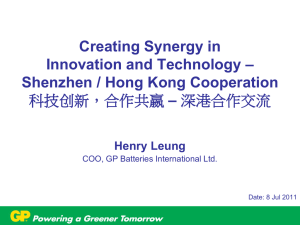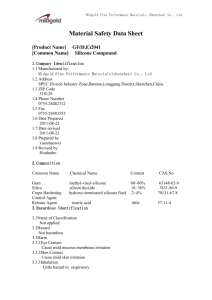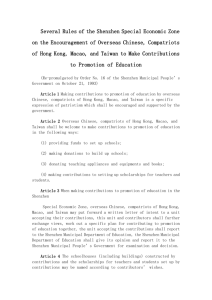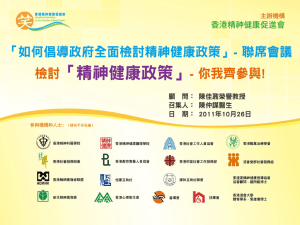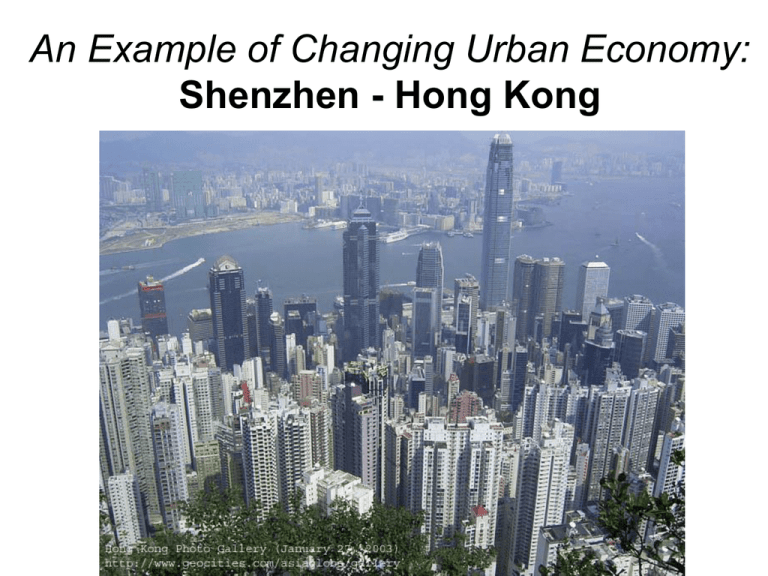
An Example of Changing Urban Economy:
Shenzhen - Hong Kong
Hong Kong – Shenzhen Area
Purple Areas are urbanized (built up)
Hong Kong
• Hong Kong grew rapidly after 1950 as it
developed as a major industrial and financial
centre for east Asia; the population today is
7.1 million.
• As wages rose, manufacturing was
increasingly replaced by the more lucrative
trade and financial businesses.
• Until about 1980, the mainland Chinese
hinterland was effectively closed to Hong
Kong.
The Financial District of Hong Kong
…with little room to grow
Shenzhen
1979
• Shenzhen, China, was a rural agricultural
area north of Hong Kong.
• Hong Kong, nearby, was not part of China.
• China was largely rural —
under-urbanized— a sort of “urbanization
vacuum.”
1979 - 2003
• In 1979 Shenzhen was opened for business
development as a Special Economic
Zone—i.e., businesses could be started
there with very few of the controls that were
in place elsewhere in China.
• In this “urbanization vacuum”, the city of
Shenzhen appeared immediately in 1979
and grew extremely rapidly—the population
today is 2.5 million in the core city, and
some 4 million in the metro area.
Shenzhen’s Economy
• The Gross Domestic Product (GDP) of the
Shenzhen region grew from $8 billion in 1980
to $89 billion in the year 2000.
• During that period, the rate of GDP growth
exceeded 16 % per year (Canada’s growth
rate was about 2.5 %).
• Shenzhen is to a large extent a
manufacturing zone for Hong Kong.
• While the economy today is based largely
on manufacturing, the financial and
service sectors are growing in
importance—i.e. Shenzhen is undergoing
a typical transition from a manufacturing to
a service economy.
The Shenzhen - Hong Kong
Region
• Rail and road connections between the two
cities are being upgraded as the economy of
the region becomes more integrated.
• The population of the Hong Kong – Shenzhen
urban region is 12 million.
• The two cities and others in the region are
beginning to function as a single extended
metropolitan area….
As a consequence, planning is now being
done on a regional basis:
The Costs of Growth in Shenzhen
• Working conditions in the manufacturing
plants are frequently prison-like.
• Sex tourism is a problem
• Air and water pollution from construction,
factories, and traffic, is severe.
Air Pollution in Shenzhen:
Trade (retail)
George Street
Duckworth Street
Turkey
Honolulu
Trade (wholesale)
Burton Upon Trent, UK
Trade (commodities)
• rural primary production makes up most of the
export production of many countries but is
distributed through cities, linking rural
communities with world markets and reinforcing
core-periphery relationships
Administration
Ottawa
Health and Education
Primary Sectors
Only a small percentage of labour force in:
• Mining
• Fishing
• Farming
“Urban Footprints”
• increasing urban spillovers that blur the
distinction between rural and urban
economies and communities
• ‘urbanization’ trend is accompanied by
growing rural-urban interdependence,
nearby rural populations maintaining a
rural residence while commuting into the
urban area for employment
• commuting distances have on average
increased in all developed countries
Source: Ali et al (2007)
St.
John’s
CMA:
Witless
Bay to
Pouch
Cove
at least 50% of the
employed labour
force living in the
CSD works in the
delineation urban
core
Census metropolitan area: urban
must have a population of at
least 100,000
Census agglomeration: urban cor
must have a population of at least
10,000
1. Strong MIZ: more than 30% of the municipality's
residents commute to work in any CMA or CA.
2. Moderate MIZ: from 5% to 30% of the
municipality's residents commute to work in any
CMA or CA.
3. Weak MIZ: from 0% to 5% of the municipality's
residents commute to work in any CMA or CA.
4. No MIZ: fewer than 40 or none of the
municipality's residents commute to work in any
CMA or CA.
- applied to CSDs outside CMAs and CAs

